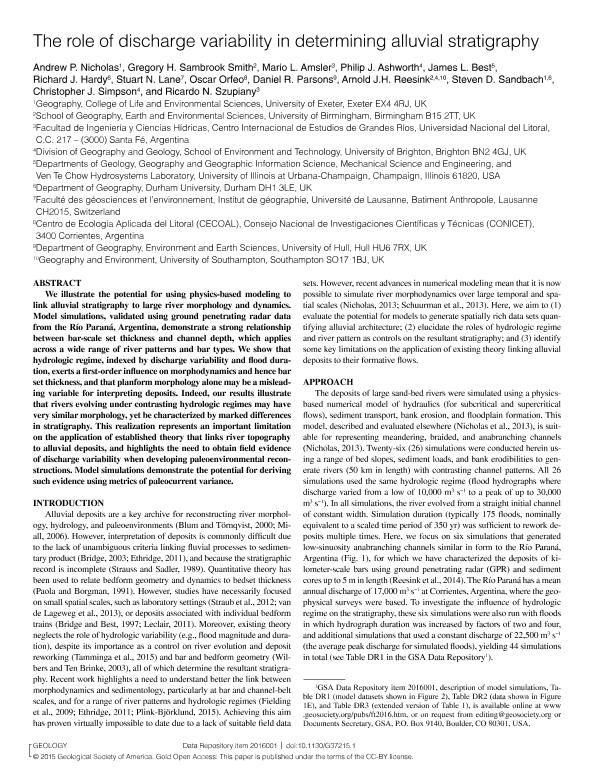Artículo
The role of discharge variability in determining alluvial stratigraphy
Nicholas, Andrew P.; Sambrook Smith, Gregory H.; Amsler, Mario Luis ; Ashworth, Philip J.; Best, James L.; Hardy, Richard J.; Lane, Stuart N.; Orfeo, Oscar
; Ashworth, Philip J.; Best, James L.; Hardy, Richard J.; Lane, Stuart N.; Orfeo, Oscar ; Parsons, Daniel R.; Reesink, Arnold J.; Sandbach, Stevend D.; Simpson, Christopher J.; Szupiany, Ricardo Nicolas
; Parsons, Daniel R.; Reesink, Arnold J.; Sandbach, Stevend D.; Simpson, Christopher J.; Szupiany, Ricardo Nicolas
 ; Ashworth, Philip J.; Best, James L.; Hardy, Richard J.; Lane, Stuart N.; Orfeo, Oscar
; Ashworth, Philip J.; Best, James L.; Hardy, Richard J.; Lane, Stuart N.; Orfeo, Oscar ; Parsons, Daniel R.; Reesink, Arnold J.; Sandbach, Stevend D.; Simpson, Christopher J.; Szupiany, Ricardo Nicolas
; Parsons, Daniel R.; Reesink, Arnold J.; Sandbach, Stevend D.; Simpson, Christopher J.; Szupiany, Ricardo Nicolas
Fecha de publicación:
11/2015
Editorial:
Geological Society of America
Revista:
Geology
ISSN:
0091-7613
e-ISSN:
0091-7613
Idioma:
Inglés
Tipo de recurso:
Artículo publicado
Clasificación temática:
Resumen
We illustrate the potential for using physics-based modeling to link alluvial stratigraphy to large river morphology and dynamics. Model simulations, validated using Ground Penetrating Radar data from the Río Paraná, Argentina, demonstrate a strong 30 relationship between bar-scale set thickness and channel depth, which applies across a wide range of river patterns and bar types. We show that hydrologic regime, indexed by discharge variability and flood duration, exerts a first-order influence on morphodynamics and hence bar set thickness, and that planform morphology alone may be a misleading variable for interpreting deposits. Indeed, our results illustrate that rivers evolving under contrasting hydrologic regimes may have very similar morphology, yet be characterized by marked differences in stratigraphy. This realization represents an important limitation on the application of established theory that links river topography to alluvial deposits, and highlights the need to obtain field evidence of discharge variability when developing paleoenvironmental reconstructions. Model simulations demonstrate the potential for deriving such evidence using metrics of paleocurrent variance.
Palabras clave:
Alluvial Stratigraphy
,
Discharge Variability
,
Gpr
,
Parana River
Archivos asociados
Licencia
Identificadores
Colecciones
Articulos(CECOAL)
Articulos de CENTRO DE ECOLOGIA APLICADA DEL LITORAL (I)
Articulos de CENTRO DE ECOLOGIA APLICADA DEL LITORAL (I)
Citación
Nicholas, Andrew P.; Sambrook Smith, Gregory H.; Amsler, Mario Luis; Ashworth, Philip J.; Best, James L.; et al.; The role of discharge variability in determining alluvial stratigraphy; Geological Society of America; Geology; 44; 1; 11-2015; 3-6
Compartir
Altmétricas



